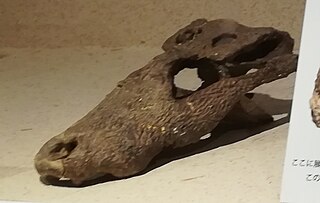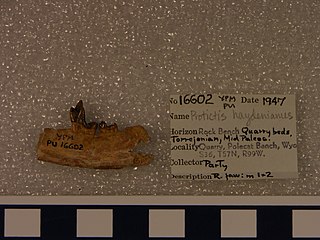
Mesonychia is an extinct taxon of small- to large-sized carnivorous ungulates related to artiodactyls. Mesonychians first appeared in the early Paleocene, went into a sharp decline at the end of the Eocene, and died out entirely when the last genus, Mongolestes, became extinct in the early Oligocene. In Asia, the record of their history suggests they grew gradually larger and more predatory over time, then shifted to scavenging and bone-crushing lifestyles before the group became extinct.

Bisonalveus is an extinct genus of shrew-like mammals that were presumably ground-dwelling and fed on plants and insects. Bisonalveus fossils have been discovered in the upper Great Plains region of North America, including sites in modern-day Wyoming, North Dakota, Montana, and Alberta. The fossils have been dated to 60 million years ago, during the Tiffanian North American Stage of the Palaeocene epoch. Bisonalveus is the last known genus of the Pentacodontinae sub-family to have arisen, replacing the genus Coriphagus in the early Tiffanian. Bisonalveus itself appears to have gone extinct by the middle Tiffanian.

Viverravidae is an extinct monophyletic family of mammals from extinct superfamily Viverravoidea within the clade Carnivoramorpha, that lived from the early Palaeocene to the late Eocene in North America, Europe and Asia. They were once thought to be the earliest carnivorans and ancestral to extant ones, but now are placed outside the order Carnivora based on cranial morphology as relatives to extant carnivorans.

Miacis is an extinct genus of placental mammals from clade Carnivoraformes, that lived in North America from the early to middle Eocene.

Miacoidea is a former paraphyletic superfamily of extinct placental mammals that lived during the Paleocene and Eocene epochs, about 66-33,9 million years ago. This group had been traditionally divided into two families of primitive carnivorous mammals: Miacidae and Viverravidae. These mammals were basal to order Carnivora, the crown-group within the Carnivoramorpha.

Ankalagon saurognathus is an extinct carnivorous mammal of the family Mesonychidae, endemic to North America during the Paleocene epoch, existing for approximately 3.1 million years.

The Fort Union Formation is a geologic unit containing sandstones, shales, and coal beds in Wyoming, Montana, and parts of adjacent states. In the Powder River Basin, it contains important economic deposits of coal, uranium, and coalbed methane.

Vulpavus is an extinct paraphyletic genus of placental mammals from clade Carnivoraformes, that lived in North America from the early to middle Eocene.

Didymictis is an extinct genus of placental mammals from extinct subfamily Didymictinae within extinct family Viverravidae, that lived in North America and Europe from the late Paleocene to middle Eocene.

The Nacimiento Formation is a sedimentary rock formation found in the San Juan Basin of western New Mexico. It has an age of 61 to 65.7 million years, corresponding to the early and middle Paleocene. The formation has yielded an abundance of fossils from shortly after the Cretaceous-Paleogene extinction event that provide clues to the recovery and diversification of mammals following the extinction event.

Navajosuchus is an extinct genus of alligatorine crocodylian. Its fossils have been found in the Paleocene-age Nacimiento Formation of the San Juan Basin, New Mexico. It was named in 1942 by Charles C. Mook, and the original type species was N. novomexicanus. N. novomexicanus was based on AMNH 5186, a partial skull collected in 1913. Later research showed that Navajosuchus novomexicanus was the same as the earlier-named Allognathosuchus mooki. However, A. mooki does not belong to the genus Allognathosuchus, and so the name of the crocodilian becomes Navajosuchus mooki. Under whichever name is used, this animal would have been a generalized predator of the Nacimiento floodplains. It was the most common Nacimiento Formation crocodilian, found in both the Puercan and Torrejonian faunal assemblages.

Brachychampsa is an extinct genus of alligatorid, possibly a basal caiman. Specimens have been reported from New Mexico, Colorado, Wyoming, Montana, North and South Dakota, New Jersey, and Saskatchewan, though only those from Montana, Utah, and New Mexico are based on material sufficient to justify the referral. Some specimens have been reported from the Campanian-aged deposits of Central Asia, although the species status is indeterminate for these fossils. The genus first appeared during the late Campanian stage of the Late Cretaceous and became extinct during the late Maastrichtian stage of the Cretaceous. Brachychampsa is distinguished by an enlarged fifth maxillary tooth in the upper jaw.

The Ojo Alamo Formation is a geologic formation in New Mexico spanning the Mesozoic/Cenozoic boundary. Non-avian dinosaur fossils have controversially been identified in beds of this formation dating from after the Cretaceous–Paleogene extinction event, but these have been explained as either misidentification of the beds in question or as reworked fossils, fossils eroded from older beds and redeposited in the younger beds.

Eoconodon is an extinct genus of triisodontid mesonychian that existed during the early Paleocene of North America. Characteristics of the genus include massive jaws, blunt builds, and strong canine teeth.
The Willwood Formation is a sedimentary sequence deposited during the late Paleocene to early Eocene, or Clarkforkian, Wasatchian and Bridgerian in the NALMA classification.

Palaeanodonta is an extinct clade of stem-pangolins. They were insectivorous (myrmecophagous), possibly fossorial, and lived from the middle Paleocene to early Oligocene in North America, Europe and Asia. While the taxonomic grouping of Palaeanodonta has been debated, it is widely thought that they are a sister group to pangolins.
Chiromyoides is a small plesiadapid primatomorph that is known for its unusually robust upper and lower incisors, deep dentary, and comparatively small cheek teeth. Species of Chiromyoides are known from the middle Tiffanian through late Clarkforkian North American Land Mammal Ages (NALMA) of western North America, and from late Paleocene deposits in the Paris Basin, France.

Protictis is an extinct paraphyletic genus of placental mammals from extinct subfamily Didymictinae within extinct family Viverravidae, that lived in North America from early Paleocene to middle Eocene.
Lamegoia is an extinct genus of mammals, belonging to the family Didolodontidae. It contains a single species, Lamegoia conodonta, which lived during the Late Paleocene in what is now South America.

Metacheiromyidae is an extinct paraphyletic family of myrmecophagous placental mammals within extinct order Palaeanodonta, that lived in North America and Europe from the late Paleocene to middle Eocene.

















